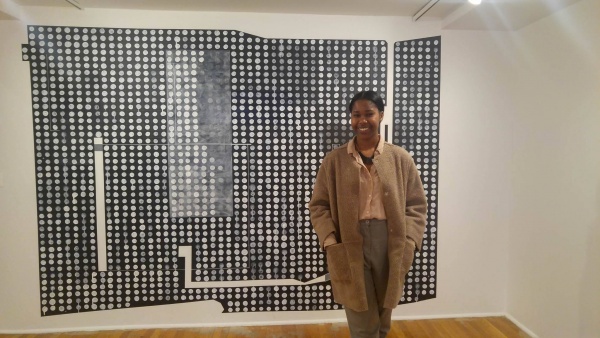Student Artist Shares Inspiration and Hopes to Break Barriers in Art
Isoke-Nilaja Cullins stands in front of an art piece at Studio Museum in Harlem, where she works as in intern in the public relations department. (PAOLA JOAQUIN ROSSO/THE OBSERVER)
November 18, 2015
For some people, the art world may come off as pretentious. At art galleries and museums, visitors can find art that uses various forms of technique ranging from renaissance to baroque, impressionism to post-impressionism and more. Isoke-Nilaja Cullins, Fordham College at Lincoln Center (FCLC ‘17), who has a rather minimalistic approach to art, hopes to bring the skills of high art to places where it is less commonly shown—that is, areas of lower socioeconomic status.
Cullins is a student artist working on a double major in visual arts and new media and digital design. In the common area of her apartment at McMahon, her painting is placed on top of a red couch and supported by the wall. The painting is of a beautiful woman with dark brown skin. Her thin silhouette is minimally curved and covered with a sleek black dress. She also wears rich, gold hoop earrings that bring out her bone structure. The lines are sharp and clean throughout the painting, and the background is a bold, deep blue hue.
“I’m exposed to a lot of different artists and different mediums…At this point, I don’t feel like I have an established style or an established medium,” Cullins said. “As far as the art that I make and how I want to present myself to the world, I haven’t really shaped that yet, and I feel like that’s an ongoing process and something that changes throughout your life, so I feel like it’s nice to just be able to make art and make things and kind of see the progression of style and…the work itself.”
On the style that she favors, Cullins said she likes minimalism. It is obvious from the outfit that she wears—it is all grey with simple, white high-top vans. Her pants have the texture of a knit sweater. “I feel like I have an established aesthetic as far as my approach to everything, like style, fashion, art … I’ve always been attracted to clean lines and geometric forms. Really, architecture is something that inspires me and inspires all of my work,” Cullins said.
Cullins also enjoys painting hard edge, a style of geometric abstract art characterized by bold colors and abrupt color transitions. The term was coined in 1959 by art historian Jules Langsner. As Cullins described it, the characteristics of this style include clean lines and bold colors. “Where the lines meet, it’s clean and straight,” she said. Cullins got the chance to experiement with this style for her painting in her dorm. She said she did this painting for a class she is currently taking. “Right now I’m painting more because I have a class…I think I really enjoy mixed media and sculpture more-so because I get to play around with different textures.”
Cullins applies her love for shapes and textures in her everyday wear as well, which translates to her minimalist fashion style. “When I pick out my clothes in the morning, I like to look at like, ‘How are the shapes? What are the shapes that I’m creating with this look? How am I mixing texture and you know, different textiles and stuff like that?’ Those are just like the details of things and kind of juxtapositions [that] really inspire me…If I’m focusing on texture or shape, keep it black. Keep it simple, and focus on one thing at a time.”
On what she hopes to communicate with her art, Cullins said she wants to make high art accessible to lower socioeconomic groups. She said she often talks with her friends about how different people appreciate art differently, “especially in varying socioeconomic classes … Like where I’m from [LA], people will kind of overlook something that focuses more on color and look at something that has a figure in it or like figurative painting because it’s something they can identify with more so. I think it’s important to democratize art in a way that everyone can appreciate it, so that it’s not so much like you have to be in a specific position in life to understand this…I think…What I hope to achieve with art is to kind of make different styles and different concepts within art accessible to everyone so that it’s not so much like an exclusive or excluding type of situation.”
Cullins also interns at the Studio Museum in Harlem in their press relations department. She had plenty of advice to give regarding how to get in the field of an art institution. “I guess my advice would be for anyone looking for an arts institution internship to not turn their nose up particularly to the position that they’re doing…You’ll have a fulfilling experience because you’ll still have to interact with the art and still have to work with the themes, and you’ll still be amongst artistic people and people who care about art. And that’s really what it’s about. It’s important what you’re doing, but as an intern you can’t really expect to be running the show,” Cullins said.
Ultimately, Cullins wants to work on progressing in her artwork and making art accessible to everyone. “I think it’s just important to be able to bring [a] high skill level of art and attention to detail to a place where everyone can access it and everyone can appreciate it. I think that’s one of my hopes with art.”










